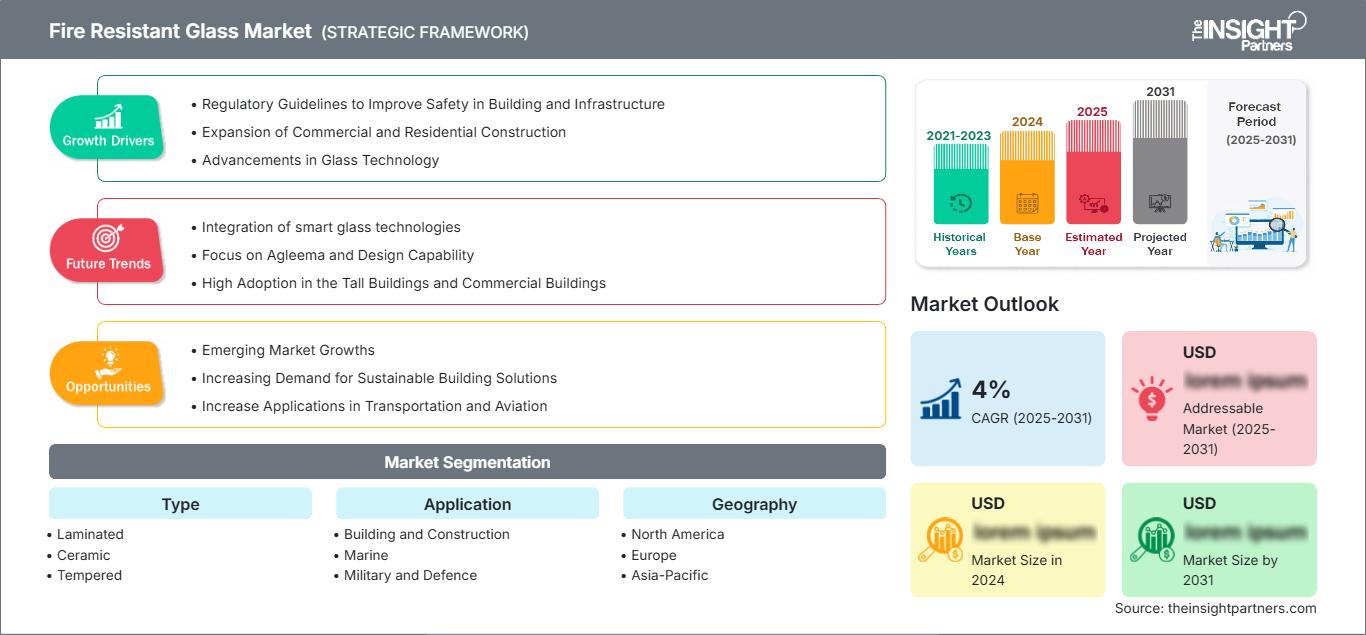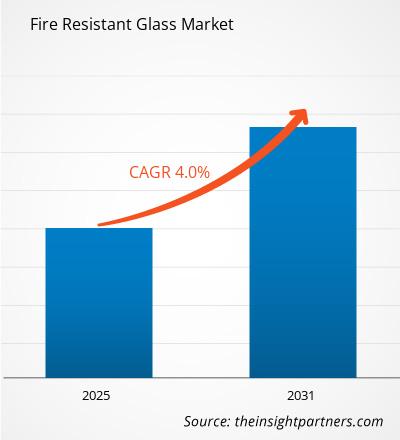预计到2031年,耐火玻璃市场规模将达到173.1亿美元。预计2025年至2031年期间,该市场将以8.8%的复合年增长率增长。
防火玻璃市场分析涵盖了按类型(夹层玻璃、陶瓷玻璃、钢化玻璃和钢丝玻璃)、应用领域(建筑、船舶、军事和国防等)以及地域(北美、欧洲、亚太、中东和非洲以及中南美洲)划分的市场情况。防火玻璃是建筑中一项至关重要的安全措施。由于人们对消防安全的日益重视,防火玻璃市场呈现增长态势。防火玻璃具有诸多优势,例如隔热、防碎、抗冲击、隔音等。近年来,防火玻璃已被广泛采用,成为传统玻璃更安全的替代品。
报告目的
The Insight Partners发布的《防火玻璃市场报告》旨在描述当前市场格局和未来增长趋势、主要驱动因素、挑战和机遇。该报告将为各类商业利益相关者提供参考,例如:
- 技术提供商/制造商:了解不断变化的市场动态和潜在的增长机会,从而能够做出明智的战略决策。
- 投资者:对市场增长率、市场财务预测以及整个价值链中存在的机会进行全面的趋势分析。
- 监管机构:监管市场政策和执法活动,旨在最大限度地减少滥用行为,维护投资者信任和信心,维护市场的诚信和稳定。
防火玻璃市场细分类型
- 层压
- 陶瓷制品
- 淬火
- 有线
应用
- 建筑施工
- 海洋
- 军事与国防
您可以免费获得任何报告的定制服务,包括本报告的部分内容、国家/地区层面的分析、Excel 数据包,以及面向初创企业和高校的优惠折扣。
防火玻璃市场:战略洞察

-
获取本报告的主要市场趋势。这份免费样品将包含数据分析,内容涵盖市场趋势、估算和预测等。
防火玻璃市场增长驱动因素
- 提升建筑和基础设施安全性的监管指南:针对建筑和基础设施项目的消防安全法规日益严格,导致对防火玻璃的需求不断增长。随着建筑规范的日益严格,防火玻璃作为门窗和隔断材料,其使用要求也越来越高,不仅要符合安全标准,还要为商业和住宅建筑提供所需的防火保护。
- 商业和住宅建筑的扩张:全球范围内,包括商业和住宅区域在内的建筑活动日益增多,这成为推动防火玻璃市场增长的重要动力。建筑商和建筑师选择防火玻璃,以确保建筑的安全性、耐久性和符合消防法规,从而为建筑行业当前及未来持续创造需求。
- 玻璃技术的进步:技术不断提升防火玻璃的性能和美观度。此外,多层玻璃和中空玻璃的引入,不仅提供了卓越的防火性能,还增强了美观性和隔音效果,从而拓宽了防火玻璃的应用范围,尤其是在高层建筑、公共场所和工业领域。
防火玻璃市场未来趋势
- 智能玻璃技术的融合:玻璃市场的新兴趋势在于将智能玻璃技术融入防火玻璃领域。这类先进玻璃的独特之处在于,它们能够自动调节透明度,从而在满足防火性能的同时,提升能源效率和舒适度。这种智能化特性在商业应用中具有巨大的潜力,例如现代住宅项目、办公设施等等。
- 关注Agleema和设计能力:安全性、舒适性和美观性是防火玻璃发展的重要趋势。建筑师和建造商通常希望设计的玻璃解决方案能够兼顾现代设计的外观与整体环境的和谐统一,兼具透明度和美感,同时满足高标准的防火要求。
- 防火玻璃在高层建筑和商业建筑中的应用日益广泛:随着城市化进程的推进,高层建筑数量不断增加,防火玻璃也因此成为一种理想的选择。高层建筑需要更严格的安全措施,而防火玻璃被广泛应用于建筑立面、空间分隔以及窗户等场所,兼具安全性和美观性。
防火玻璃市场机遇
- 新兴市场增长:随着新兴经济体的扩张,防火玻璃的需求日益增长。城市化进程势必会催生更多建筑法规,而防火玻璃产品的市场需求在亚洲和非洲等地区,例如住宅、商业和工业建筑领域,都蕴藏着巨大的机遇。
- 对可持续建筑解决方案的需求日益增长:人们对可持续建筑的关注度不断提高,推动了防火、隔热和节能玻璃产品的市场增长。在这种趋势下,制造商可以通过提供符合消防安全标准且满足绿色建筑开发商要求的环保、节能、防火玻璃解决方案,获得诸多商机。
- 交通运输和航空领域的应用日益广泛:机车和飞机行业对防火亚克力板的接受度越来越高。高速列车和航空母舰对防火亚克力板的需求日益增长,因为它们需要满足高温、高透明度和安全性的要求。随着航空和铁路运输的不断发展,这些市场的机遇预计也将持续增加。
防火玻璃市场区域洞察
The Insight Partners 的分析师对预测期内影响防火玻璃市场的区域趋势和因素进行了详尽的阐述。本节还探讨了北美、欧洲、亚太、中东和非洲以及南美和中美洲等地区的防火玻璃市场细分和地域分布情况。
防火玻璃市场报告范围
| 报告属性 | 细节 |
|---|---|
| 2024年市场规模 | XX亿美元 |
| 到2031年市场规模 | 173.1亿美元 |
| 全球复合年增长率(2025-2031年) | 8.8% |
| 史料 | 2021-2023 |
| 预测期 | 2025-2031 |
| 涵盖部分 |
按类型
|
| 覆盖地区和国家 |
北美
|
| 市场领导者和主要公司简介 |
|
防火玻璃市场参与者密度:了解其对业务动态的影响
受终端用户需求不断增长的推动,防火玻璃市场正快速发展。终端用户需求增长的驱动因素包括消费者偏好的转变、技术的进步以及消费者对产品优势的认知度提高。随着需求的增长,企业不断拓展产品线、创新以满足消费者需求并把握新兴趋势,这些都进一步推动了市场增长。

- 获取防火玻璃市场主要参与者概览
主要卖点
- 全面覆盖:该报告全面分析了防火玻璃市场的产品、服务、类型和最终用户,提供了一个全面的市场概况。
- 专家分析:该报告是根据行业专家和分析师的深入理解编制的。
- 最新信息:该报告涵盖了最新的信息和数据趋势,确保了其与业务的相关性。
- 定制选项:本报告可根据客户的具体需求进行定制,并能恰当地适应业务战略。
因此,这份关于防火玻璃市场的研究报告有助于深入了解和解读行业现状及增长前景。尽管其中可能存在一些合理的担忧,但总体而言,这份报告的优势远大于劣势。
- 历史分析(2 年)、基准年、预测(7 年)及复合年增长率
- PEST和SWOT分析
- 市场规模、价值/数量 - 全球、区域、国家
- 行业和竞争格局
- Excel 数据集
近期报告
相关报告
客户评价
购买理由
- 明智的决策
- 了解市场动态
- 竞争分析
- 客户洞察
- 市场预测
- 风险规避
- 战略规划
- 投资论证
- 识别新兴市场
- 优化营销策略
- 提升运营效率
- 顺应监管趋势






















 获取免费样品 - 防火玻璃市场
获取免费样品 - 防火玻璃市场